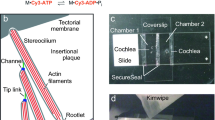Summary
Triphosphoinositide (TPI) has been demonstrated to be a receptor for aminoglycosides in the cochlea and may regulate ionic permeability by its binding with Ca++. This phospholipid was localized by a protein A-gold technique in the cochlea at the electronmicroscopic level. TPI was prepared by a neomycin column and antibodies to it were raised in rabbits. The antibody used in this study reacted virtually only to TPI among the tested lipids. TPI was localized mainly at stereocilia, cuticular plates, head plates of Deiter's cells, plasma membrane, and mitochondria of various cells in the organ of Corti. In the vascular stria, TPI was found mainly at the plasma membrane of basal infoldings of the marginal cells. Possible physiological and pathophysiological roles of TPI in the cochlea are briefly discussed.
Similar content being viewed by others
References
Eichberg J, Hauser G (1973) The subcellular distribution of polyphosphoinositides in myelinated and unmyelinated rat brain. Biochim Biophys Acta 326:210–223
Farese RV, Sabir AM, Vandor SL, Larson RE (1980) Are polyphosphoinositides the cycloheximide-sensitive mediator in the steroidogenetic actions of adrenocorticotropin and adenosine-3′,5′-monophosphate? J Biol Chem 225:5728–5734
Flock Å, Anthony B, Weber K (1982) Immunohistochemical localization of several cytoskeletal proteins in inner car sensory and supporting cells. Hearing Res 6:75–89
Hendrickson HS, Reinertsen JL (1971) Phosphoinositide interconversion: a model for control of Na+ and K+ permeability in the nerve axon membrane. Biochem Biophys Res Commun 44:1258–1264
Hudspeth AJ (1983) The hair cells of the inner ear. Sci Am 248:54–64
Kataoka T, Nojima S (1970) Immunochemical studies of phospholipids. VI. Haptenic activity of phosphatidylinositol and the role of lecithin as an auxiliary lipid. J. Immunol 105:502–511
Komune S, Snow JB (1981) Ototoxicity of kanamycin sulfate and the barrier in the inner ear. Otolaryngol Head Neck Surg 89:1013–1018
Mees K (1983) Ultrastructural localization of K+-dependent, ouabain-sensitive NPPase (Na−K-ATPase) in the guinea pig inner ear. Acta Otolaryngol 95:277–289
Moran DT, Rowley JC, Asher DL (1981) Calcium-binding sites on sensory processes in vertebrate hair cells. Proc Natl Acad Sci USA 78:3954–3958
Orsulakova A, Stockhorst E, Schacht J (1976) Effect of neomycin on phosphoinositide labelling and calcium binding in guinea pig inner ear tissue in vivo and in vitro. J Neurochem 26:285–290
Roth J, Bendayan M, Orchi L (1978) Ultrastructural localization of intracellular antigens by the use of protein A-gold complex. J Histochem Cytochem 26:1074–1081
Schacht J (1974) Interaction of neomycin with phosphoinositide metabolism in guinea pig inner ear and brain tissue. Ann Otol 83:813–818
Schacht J (1978) Purification of polyphosphoinositides by chromatography on immobilized neomycin. J Lipid Res 19:1063–1067
Schacht J (1979) Isolation of an aminoglycoside receptor from guinea pig inner ear tissue and kidney. Arch Otorhinolaryngol 224:129–134
Schacht J (1982) Adenylate cyclase and cochlear fluid balance. Am J Otolaryngol 3:328–331
Sokabe M (1975) Cation channel induced by lysotriphosphoinositide. Master Thesis Fac Engineering Sci Osaka University
Sokabe M (1982) Polyphosphoinositides in artificial bilayer lipid membranes: The nature of the Ca++-gated conductance of lysotriphosphoinositide channel. Bull Facul Human Sci, Osaka Univ 8:241–288
Tachibana M, Anniko M, Schacht J (1983) Effects of perilymphatically perfused gentamicin on microphonic potential, lipid labeling and morphology of cochlear tissues. Acta Otolaryngol 96:31–38
Weiner ND, Schacht J (1981) Biochemical model of amioglycoside-induced hearing loss. In: Lerner SA, Matz GJ, Hawkins JE Jr (eds) Aminoglycoside ototoxicity. Little, Brown, Boston, pp 113–121
Wersäll J (1981) Histopathology of cochlear and vestibular otoxicity in laboratory animals. In: Lerner SA, Matz GJ, Hawkins JE Jr (eds) Aminoglycoside ototoxicity. Little, Brown, Boston, pp 197–214
Horikoshi T, Yanagisawa K, Yoshioka T (1984) in preparation
Zajic G, Anniko M, Schacht J (1983) Cellular localization of adenyl cyclase in the mature inner ear of the mouse. Hearing Res 10:249–261
Author information
Authors and Affiliations
Rights and permissions
About this article
Cite this article
Tachibana, M., Morioka, H., Machino, M. et al. Localization of triphosphoinositide in the cochlea. Histochemistry 81, 157–160 (1984). https://doi.org/10.1007/BF00490110
Accepted:
Issue Date:
DOI: https://doi.org/10.1007/BF00490110




